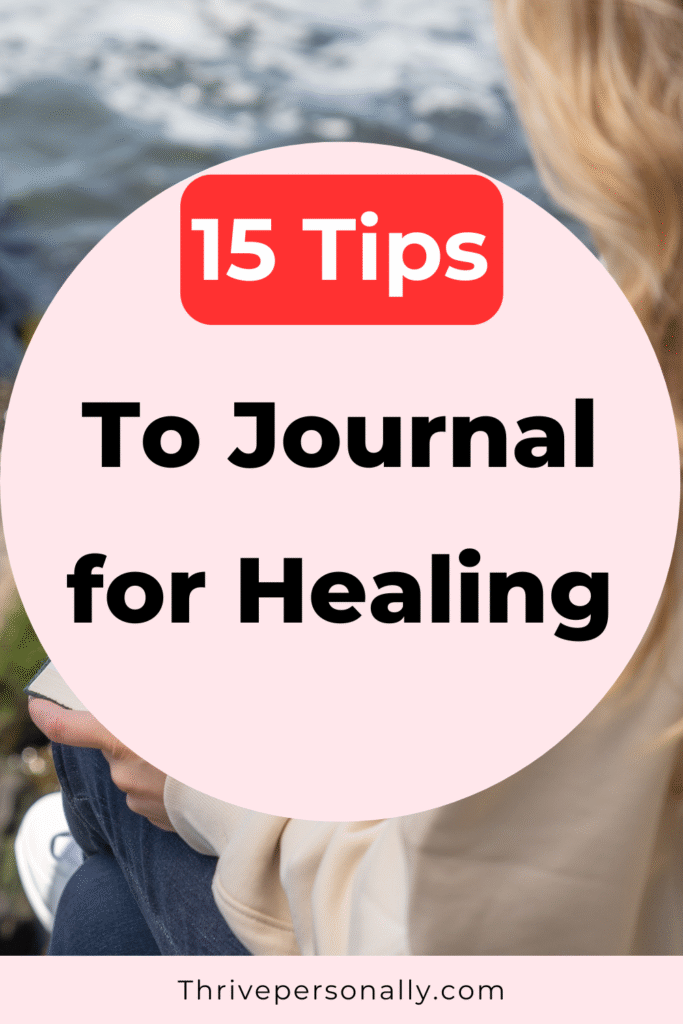Life can feel heavy sometimes. You carry pain from the past, stress from today, and fears about what’s coming next. Even when you smile and keep going, something inside might still feel stuck or worn out.
That’s where true healing begins—not from the outside world, but from within.
And one of the simplest, most powerful tools to help that healing happen is journaling.
Journaling isn’t about being a good writer or saying things the “right” way. It’s about getting your thoughts out of your head and onto the page. No one else needs to see it. It’s just you, being honest, real, and open with yourself. That kind of truth is where healing begins.
If you’ve never journaled before—or if you’ve tried but found it hard to keep going—this guide is for you. These 15 tips will help you journal in a way that brings calm, clarity, and connection with yourself.
You don’t need special tools. Just a notebook, a pen, and the willingness to start.
15 Tips on How to Journal for Healing
1. Start with How You Feel
When you sit down to journal, begin with what’s going on inside. Are you feeling sad, angry, numb, tired, or unsure? You don’t need to explain why—just name the feeling. Writing it down helps you face it instead of hiding from it.
Read also: 45 Confidence-Building Journaling Prompts
2. Don’t Worry About Grammar or Spelling
This is your space. You’re not writing a school paper or something for others to read. Let go of “perfect” grammar. Let your words flow without judgment. This is about release, not perfection.
3. Write Like No One Will Ever Read It
To truly heal, you need to feel safe on the page. Write the truth—even if it’s messy. If you’re worried someone might find it, keep it in a private spot or use a secure app. When you stop censoring yourself, real freedom starts.
Read also: 8 Way to Write a Nice Reading Journal
4. Make It a Daily Habit
Healing takes time. Try writing a little each day, even just for five minutes. Some days you’ll have more to say. Some days you won’t. That’s okay. The habit itself becomes healing.
5. Let Yourself Cry or Pause
Journaling can bring strong feelings to the surface. If tears come or you feel overwhelmed, let it happen. Take a break if you need to. This is part of healing—not a sign that something is wrong.
Read also: 15 Life-Changing Benefits of Journaling
6. Use Prompts to Get Started
Not sure what to write? Use a simple question to guide you:
-
“What’s been bothering me lately?”
-
“What do I wish I could say?”
-
“What do I need right now?”
You can also explore this helpful list of Positive Psychology: Journal Prompts for Mental Health to spark deeper reflection.
7. Let Go of the Need to Fix Everything
You don’t have to solve your life in one journal entry. You don’t even need a plan. Just write what’s on your heart. Journaling gives your emotions space to breathe—and with time, things start to make more sense.
8. Write Letters You Don’t Send
If someone hurt you, or if there’s something left unsaid, write them a letter. Don’t send it—just write what you wish you could say. It helps you release emotion and find peace without needing anyone else’s response.
9. Revisit Old Entries With Kindness
After a few weeks, go back and read what you wrote earlier. Notice how your feelings have changed. See the growth. Be gentle with your past self. That version of you was doing their best.
10. Focus on Your Own Voice
Don’t write what you think you should feel. Write what you really feel. Be honest. This builds trust in yourself. Over time, your inner voice becomes stronger and clearer.
11. Add Gratitude, Even on Hard Days
Even when life is hard, there’s usually something small to be thankful for. A smile, a warm drink, a quiet moment. Gratitude doesn’t erase pain—but it brings light into dark places. Try ending your entries with a short list of things you’re grateful for.
12. Create a Safe Writing Space
Where you write matters. Find a quiet spot where you feel safe. Use a notebook you like or an app that feels private. Make it your own little corner for honesty and healing.
13. Don’t Compare Your Healing to Anyone Else
Healing is not a race. It doesn’t look the same for everyone. Some days will feel like progress. Other days might feel like setbacks. That’s okay. Your journey is yours alone—and your journal is a reflection of that.
14. Let Your Journal Grow With You
As you grow, let your journaling style grow too. Maybe you’ll start using lists. Maybe you’ll draw, write poems, or add quotes. Your journal doesn’t have to look one way. Let it be as unique as you are.
15. Use Journaling Alongside Other Healing Tools
Journaling is powerful, but it doesn’t have to stand alone. It works beautifully alongside therapy, meditation, or simply talking to someone you trust. If you’re dealing with deep pain or mental health struggles, journaling can support you—but don’t be afraid to reach out for more help.
For more on how journaling supports your mental health, check out this article from Healthline: How Journaling Helps Mental Health.
Final Thoughts
Healing doesn’t follow a straight line. Some days you’ll feel lighter. Other days, heavier. That’s all part of the process.
Your journal can hold all of it—the pain, the questions, the growth, the gratitude.
It’s your safe space. Your voice. Your truth.
And most of all, it’s your reminder that healing is possible—one honest page at a time.
Start small. Be real. Keep showing up.
You don’t need a perfect journal.
You just need one that’s true.
Save the pin for later



